NASA has announced the launch window for its Artemis 2 mission, which will send four astronauts on a journey around the moon for the first time in over half a century. The 10-day flight could lift off as early as February 5, 2026, marking a critical step in the agency's plan to return humans to the lunar surface. Officials confirmed the timeline during a press event at the Johnson Space Center in Houston.
Key Takeaways
- Launch Window: Artemis 2 is scheduled to launch between February 5 and April 26, 2026.
- Mission Goal: A 10-day crewed flyby of the moon, serving as a test flight for the Orion spacecraft and its systems.
- Crew Members: The mission includes NASA astronauts Reid Wiseman, Victor Glover, Christina Koch, and Canadian Space Agency astronaut Jeremy Hansen.
- Safety Focus: NASA emphasized that crew safety is the primary factor determining the final launch date, following lessons learned from the uncrewed Artemis 1 mission.
Mission Timeline and Objectives
NASA has identified several launch opportunities for Artemis 2 in early 2026. According to mission managers, the first available date is February 5, with subsequent windows in March and April. The latest possible launch date in this period is April 26.
Lakiesha Hawkins, NASA's acting deputy associate administrator for exploration systems development, stated that while the agency aims for the earlier part of the window, the schedule remains flexible. "We want to emphasize that safety is our top priority," Hawkins said. "As we work through these operational preparations... we're continuing to assess to make sure that we do things in a safe way."
The mission itself is planned to last approximately 10 days. It will not land on the moon but will instead perform a lunar flyby on a "free-return trajectory." This path uses the moon's gravity to naturally guide the spacecraft back to Earth, a crucial safety feature for this test flight.
A Deeper Journey into Space
The Orion spacecraft will travel farther beyond the moon than any previous crewed mission. Jeff Radigan, the lead Artemis 2 flight director, noted the unique perspective the crew will experience.
"They're going at least 5,000 nautical miles [9,260 kilometers] past the moon, which is much higher than previous missions have gone," Radigan explained. "So, the moon's going to look a little bit smaller."
This deep-space journey is designed to rigorously test Orion's life support systems, navigation, and communication capabilities in an environment far from Earth, paving the way for future, more complex missions.
Meet the Artemis 2 Crew
The four-person crew represents a new generation of lunar explorers. The mission will be led by seasoned NASA astronauts and includes an international partner, highlighting the collaborative nature of the Artemis program.
The First Crew to the Moon in Over 50 Years
Artemis 2 will be the first crewed mission to travel to the vicinity of the moon since Apollo 17 in December 1972. The mission carries the historic weight of re-establishing a human presence in deep space.
The crew consists of:
- Reid Wiseman (Commander): A NASA astronaut and former naval aviator, Wiseman previously served as Chief of the Astronaut Office.
- Victor Glover (Pilot): Glover is an experienced NASA astronaut who piloted the first operational flight of the SpaceX Crew Dragon spacecraft.
- Christina Koch (Mission Specialist): Koch holds the record for the longest single spaceflight by a woman and was part of the first all-female spacewalk.
- Jeremy Hansen (Mission Specialist): A Canadian Space Agency astronaut, Hansen's inclusion marks the first time a non-American will fly to the moon.
Their mission is to validate all the systems on the Orion spacecraft, ensuring it is ready to support astronauts on long-duration missions to the moon and, eventually, Mars.
Lessons Learned from Artemis 1
The Artemis 2 mission schedule directly incorporates findings from its uncrewed predecessor, Artemis 1, which flew in late 2022. That mission successfully sent an Orion capsule to lunar orbit and back, but engineers noted unexpected issues that required resolution before putting a crew on board.
One major focus has been the spacecraft's heat shield. During Artemis 1's fiery reentry into Earth's atmosphere, the shield charred more severely than models predicted. Rick Henfling, the lead entry flight director for Artemis 2, confirmed that extensive testing has led to a better understanding of the issue.
"The Artemis 2 trajectory that we're going to fly is going to be one that is not going to replicate that temperature environment," Henfling stated, explaining that the new flight path will reduce thermal stress on the shield.
Solving Launch Pad Challenges
Engineers have also addressed technical hurdles that delayed the Artemis 1 launch. Persistent liquid hydrogen leaks during fueling were a significant problem. Charlie Blackwell-Thompson, NASA's launch director, explained that the team has since implemented solutions.
"We learned an awful lot during Artemis 1," Blackwell-Thompson said. She noted that modifications to the launch pad and adjustments to the fueling process have been made to minimize the risk of similar leaks for Artemis 2. These changes are crucial for ensuring a smooth and safe countdown.
The Path to Launch
The physical components for the historic mission are coming together at NASA's Kennedy Space Center in Florida. The massive Space Launch System (SLS) rocket is nearly fully assembled inside the Vehicle Assembly Building. Its solid rocket boosters, built by Northrop Grumman, are already attached to the Boeing-built core stage.
In the coming weeks, the Orion spacecraft and its service module will be stacked on top of the rocket. NASA expects to present the fully assembled Artemis 2 vehicle to the public in October, a major milestone on the journey to the launch pad.
Despite the hardware progress, officials continue to describe Artemis 2 as a test flight with multiple objectives. "A test flight doesn't have one singular objective; it's got many of them," said flight director Jeff Radigan. He concluded that the ultimate measure of success is simple and profound.
"To call this mission fully successful, we need to go fly by the moon, bring the crew home safely and welcome them back with open arms."
This mission will provide the essential data and experience needed for Artemis 3, which aims to land the first woman and the next man on the lunar surface later this decade.





